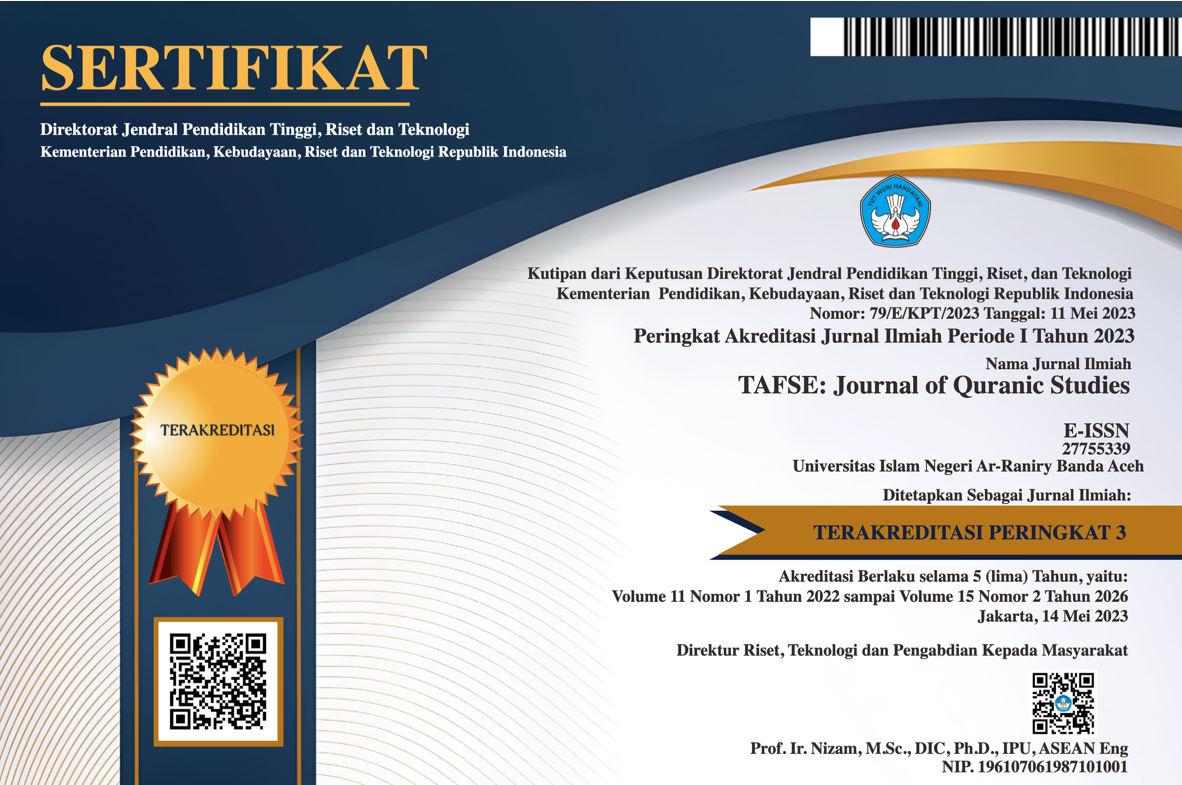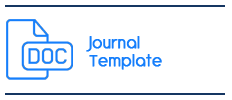Pemaknaan Kiamat dalam Penafsiran Umar Sulaiman Abdullah Al-Asyqar
DOI:
https://doi.org/10.22373/tafse.v4i2.13180Keywords:
Penafsiaran, Kiamat, TematikAbstract
In the Qur'an there are many verses that talk about the apocalypse, there are also various interpretations produced by the interpreters. This paper wants to examine the interpretation and understanding of Umar Sulaiman al-Asyqar regarding the doomsday verse, this may be different from other commentators because of the different methods and characteristics of interpretation. This research is a bibliographical study with the data sources being the books of al-Ma'ānī al-Ḥasān fī Tafsīr al-Qur'ān and al-'Aqīdah fi 'i al-Kitāb wa al-Sunnah: al-Qiyāmah al-Kubra. Data was collected through thematic methods), and the analysis was carried out descriptively. The results of the study indicate that Umar Sulaiman interprets the word tafjīr as having the same meaning (synonym) as the word tasjīr which means burning (انفجار) or exploding (انسجار), while previous commentators distinguish the word tafjīr which means mixed up (إختلاط) with the word tasjīr which means lit (إضطرام).
Dalam al-Qur’an terdapat banyak ayat yang berbicara mengenai kiamat, terdapat beragam pula penafsiran yang dihasilkan oleh para penafsir. Tulisan ini ingin mengkaji penafsiran dan pemahaman Umar Sulaiman al-Asyqar mengenai ayat kiamat, hal ini berkemungkinan berbeda dengan mufasir lainnya karena metode dan karakteristik penafsiran yang berbeda. Penelitian ini bersifat kepustakaan dengan sumber data kitab al-Ma‘ānī al-Ḥasān fī Tafsīr al-Qur‘ān dan al-‘Aqīdah fi Ḍū’i al-Kitāb wa al-Sunnah: al-Qiyāmah al-Kubra. Pengumpulkan data dilakukan melalui metode tematik), dan analisi dilakukan secara deskriptif. Hasil dari penelitian menunjukkan bahwa Umar Sulaiman menafsirkan kata tafjīr mempunyai persamaan makna (sinonim) dengan kata tasjīr yang diartikan menyala (انفجار) atau meledak (انسجار), sedangkan mufasir terdahulu membedakan kata tafjīr yang diartikan bercampur baur (إختلاط) dengan kata tasjīr yang diartikan menyala (إضطرام).
Downloads
References
Abu Abdullah Muhammad al-Bukhari. Saḥīḥ al-Bukhāri, Jilid 4. Beirut: Dār al-Fikr, 1401 H./ 1981 M.
Abu Abdullah Muhammad al-Qurṭubi. al- Jāmi’ al-Aḥkam al-Qur‘an. Kairo: Dār al-Kātib al-‘Arabi, 1387 H./ 1967 M.
Ibnu Kathir. Tafsir Ibnu Kathir, Terj. M. ‘Abdul Ghoffar, Jilid 4. Jakarta: Pustaka Imam al-Syafi’i, 2009.
.
Jalaluddin ‘Abdurrahman al-Suyūṭi. al-Dur al-Manthūr fi al-Tafsīr al-Ma’thūr, Cet. 1, jilid. 6. Beirūt: Dār al-Kutub al-‘Ilmiah, 2000 M./ 1461 H.
Muhammad Sulaiman Abdullah al-Asyqar. Zubdah al-Tafsīr, Cet. 1. Yordania: Dār al-Nafā’is, 1434 H./ 2013 M.
Siradjuddin Abbas. I’tiqad Ahlussunnah wal Jamaah, Cet. 18. Jakarta: Pustaka Tarbiyah Baru, 2015 M./1436 H.
Umar Sulaiman Abdullah al-Asyqar. al-Ma‘ānī al-Ḥasān fī Tafsīr al-Qur‘ān, Cet. 1, Jilid 3. Amman: Dār al-Nafā’is, 1436 H./ 2015 M.
________. al-‘Aqīdah fi Ḍaw’i al-Kitāb wa al-Sunnah : al-Qiyamah al-Kubra, Cet. 13. Yordania: Dār al-Nafāis, 1423 H./ 2004 M.
Umar Sulaiman al-Asyqar. Ensiklopedia Kiamat: Dari Sakaratul Maut hingga Syurga-Neraka, terj. Irfan Salim, dkk, Cet. 1. Jakarta: Zaman, 2011.
Yusuf Qardhawi. Berinteraksi dengan al-Qur`an, Terj. Abdul Hayyie Al-Kattani, Cet. 1. Jakarta: Gema Insani Press, 1999.
Downloads
Published
Issue
Section
License
Authors who publish with this journal agree to the following terms:
- Authors retain copyright and grant the journal right of first publication with the work simultaneously licensed under a Creative Commons Attribution License (CC BY NC 4.0) that allows others to share the work with an acknowledgment of the work's authorship and initial publication in this journal.
- Authors are able to enter into separate, additional contractual arrangements for the non-exclusive distribution of the journal's published version of the work (e.g., post it to an institutional repository or publish it in a book), with an acknowledgment of its initial publication in this journal.
- Authors are permitted and encouraged to post their work online (e.g., in institutional repositories or on their website) prior to and during the submission process, as it can lead to productive exchanges, as well as earlier and greater citation of published work (See The Effect of Open Access).





